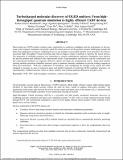Turbocharged molecular discovery of OLED emitters: from high-throughput quantum simulation to highly efficient TADF devices
Author(s)
Gómez-Bombarelli, Rafael; Aguilera-Iparraguirre, Jorge; Hirzel, Timothy D.; Aspuru-Guzik, Alán; Ha, Dong-Gwang; Einzinger, Markus; Wu, Tony C; Baldo, Marc A; ... Show more Show less
DownloadTurbocharged molecular.pdf (3.804Mb)
PUBLISHER_POLICY
Publisher Policy
Article is made available in accordance with the publisher's policy and may be subject to US copyright law. Please refer to the publisher's site for terms of use.
Terms of use
Metadata
Show full item recordAbstract
Discovering new OLED emitters requires many experiments to synthesize candidates and test performance in devices. Large scale computer simulation can greatly speed this search process but the problem remains challenging enough that brute force application of massive computing power is not enough to successfully identify novel structures. We report a successful High Throughput Virtual Screening study that leveraged a range of methods to optimize the search process. The generation of candidate structures was constrained to contain combinatorial explosion. Simulations were tuned to the specific problem and calibrated with experimental results. Experimentalists and theorists actively collaborated such that experimental feedback was regularly utilized to update and shape the computational search. Supervised machine learning methods prioritized candidate structures prior to quantum chemistry simulation to prevent wasting compute on likely poor performers. With this combination of techniques, each multiplying the strength of the search, this effort managed to navigate an area of molecular space and identify hundreds of promising OLED candidate structures. An experimentally validated selection of this set shows emitters with external quantum efficiencies as high as 22%.
Date issued
2016-09Department
Massachusetts Institute of Technology. Department of Electrical Engineering and Computer ScienceJournal
Proceedings of SPIE--the Society of Photo-Optical Instrumentation Engineers
Publisher
SPIE
Citation
Gómez-Bombarelli, Rafael; Aguilera-Iparraguirre, Jorge; Hirzel, Timothy D. et al. “Turbocharged Molecular Discovery of OLED Emitters: From High-Throughput Quantum Simulation to Highly Efficient TADF Devices
.” Edited by Franky So, Chihaya Adachi, and Jang-Joo Kim. Organic Light Emitting Materials and Devices XX (September 2016): 99410A © 2016 SPIE
Version: Final published version
ISSN
0277-786X
1996-756X